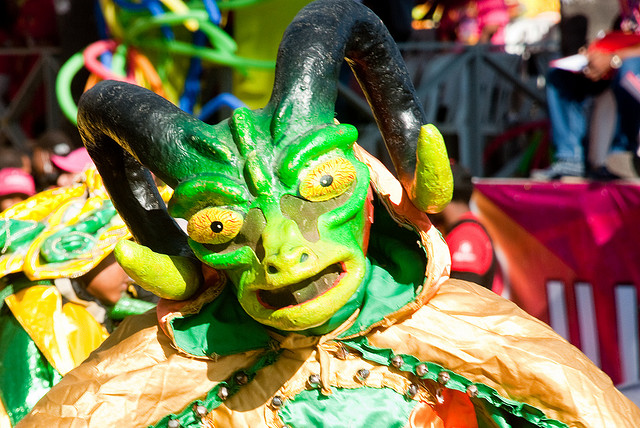
A colorful devil mask at Carnaval in Santo Domingo. Photo © Max Bosio, licensed Creative Commons Attribution.
Carnaval, generally observed throughout the Dominican Republic during the month of February (though for some areas, March), is steeped in tradition and historical significance. This Catholic-based, pre-Lenten festival was brought to the island by the Spanish and throughout the centuries has blended with the customs of Taíno and African cultures. It has become a celebration of life in a country whose people have such a rich culture and diverse heritage. Different regions tend to have their own customs and rituals pertaining to the occasion, but all exhibit a wealth of spirit and creativity, with local folklore coming alive in the form of masks and the characters adopted by those who don them.La Vega is one of the most popular places to experience Carnaval, which it has been practicing for over 500 years. The celebration occurs every weekend during the month of February, culminating on the last Sunday of the month. Preparations—particularly the planning and crafting of costumes—begin months in advance. Registered groups of at least 10–15 people team up to create a theme for themselves and carry on together in the streets. La Vega’s signature character is the diablo cojuelo (mischievous devil). Generally, the masks tend to be on the more grotesque side, with horns and elaborate facial features. People wearing these demon-esque masks run through the crowds walloping folks with inflated pig or cow bladders and whips. Other sub-events—like music and food and dancing—are often scheduled throughout the month, but the costumes and raucous, prankish behavior of the people sporting them truly make Carnaval a spectacular celebration.
Santiago is also host to a very popular Carnaval, one of the more traditional celebrations. Parades and mask-making competitions often get things started. Masks here tend to display a more animal-like theme, with two styles in particular: From the La Joya sector, masks sport horns aplenty, while the Los Pepines masks have a more duck-like appearance. The traditional lechon (pig) character originated in Santiago.
In Santiago, as well as in La Vega, the celebrations occur on two levels, the public and the private. While the street festivals with their dance troupes and parades are the main attractions, private businesses and clubs often conduct their own parties as well.
Most masks are derived from the theme of el diablo (the devil) but are known by different names and vary in depiction in different regions. The diablo cojuelo is the lame devil, named so because, having fallen when he was banished to earth, he walks with a limp. Those who wear the mask of this character must hobble about the streets. Cachuas, in Cabral, are horned devils. In Monte Cristi, the theme of civiles and toros presides, where the toros run about chasing down the civiles. In Santo Domingo and other areas men dressed as large-breasted women flirt with the crowds, who yell at them, “Roba la gallina!” which means, “Steal the hen!”
The largest and most spectacular Carnaval is celebrated in Santo Domingo. People from all over the country—and the world—commence to memorialize the day the Dominican Republic won its independence from Haiti. Costumes and celebrators of all regional backgrounds come together in the capital, where devils, duck-faced monsters, toros, transvestites, and horn-headed creatures run amok in the joyful spirit of their country.
Excerpted from the Fourth Edition of Moon Dominican Republic.